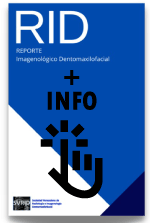Cambios cefalométricos de la vía aérea en paciente con glosectomía. Reporte de caso
DOI:
https://doi.org/10.60094/RID.20230202-34Palabras clave:
Macroglosia, glosectomía, obstrucción de vías aéreasResumen
Las vías aéreas superiores (VAS) están constituidas por la nasofaringe, orofaringe e hipofaringe, siendo estructuras que pueden sufrir obstrucciones por cambios en la forma, tamaño y posición de la mandíbula, la lengua y el hioides, repercutiendo en el crecimiento y desarrollo del macizo facial. La macroglosia es una patología caracterizada por un sobrecrecimiento tisular transversal y sagital de la lengua, causante de anomalías dento-esqueléticas, deficiencias funcionales y obstrucción de la VAS. En este contexto, la valoración del tamaño de la lengua debe incluir datos clínicos, radiográficos y funcionales. A continuación se presenta un caso clínico de paciente clase II esquelética con macroglosia atendido en el postgrado de Ortopedia Dentofacial y Ortodoncia de la Universidad de Carabobo; se describen los estudios clínicos y los cambios cefalométricos en la VAS observados en la radiografía cefálica lateral antes y posterior a glosectomía parcial, utilizando los análisis de McNamara y Linder-Aronson que señalan diámetro faríngeo y el análisis de Rakosi que puntualiza posición de lengua en cavidad bucal al inicio del tratamiento. Los estudios efectuados a los 18 meses de tratamiento evidencian mejoría en la permeabilidad de las VAS y en la oclusión.
Descargas
Citas
Espada M, Soldevilla L y Mattos M. Posición hioidea, posición lingual y dimensión de la vía aérea faríngea según maloclusión esquelética. Odontoest. 2021;23(38):305. DOI: https://doi.org/10.22592/ode2021n37e305
Saldarriaga J, Álvarez E, Botero P. Tratamientos para la maloclusión Clase II esquelética combinada. Rev. CES Odont. 2013;26(2):145-59. DOI: https://doi.org/10.21615/cesodon
Xiang M, Hu B, Liu Y, Sun J, Song J. Changes in airway dimensions following functional appliances in growing patients with skeletal class II malocclusion: a systematic review and meta-analysis. Int J Pediatr Otorhinolaryngol 2017;97:170e80. DOI: https://doi.org/10.1016/j.ijporl.2017.04.009
Iwasaki T, Suga H, Minami A, Sato H, Hashiguchi M, Tsujii T. Relationships among tongue volume, hyoid position, airway volume and maxillofacial form in paediatric patients with Class-I, Class-II and Class-III malocclusions. Orthod Craniofac. 2019;22(1):9-15. DOI: https://doi.org/10.1111/ocr.12251.
Quevedo M, Hernández A, Zambrano E, Domingos V. Evaluación de las vías aéreas superiores a través de trazados cefalométricos. Rev Odontol Univ Cid São Paulo 2017;29(3):276-88. DOI: https://doi.org/10.26843/ro_unicidv2932017p276-288
Vilella B de S, Vilella O de V, Koch HA. Growth of the nasopharynx and adenoidal development in Brazilian subjects. Braz Oral Res. 2006;20(1):70–5. DOI: http://dx.doi.org/10.1590/s1806-83242006000100013
Núñez P, García C, Morán V y Jasso L. Macroglosia congénita: características clínicas y estrategias de tratamiento en la edad pediátrica. Bol Med Hosp Infant Mex. 2016;73(3):212-216. DOI: https://doi.org/10.1016/j.bmhimx.2016.03.003
Prada C, Zarate Y, Hopkin R. Genetic causes of macroglossia: diagnostic approach. Pediatrics. 2012;129(2):e431-7. DOI: https://doi.org/10.1542/peds.2011-1732
Herrera A, Herrera F, Díaz A, y Fang L. Glosectomía parcial. Una técnica quirúrgica para tratamiento de macroglosia. Ciencia y Salud Virtual (CSV) 2013;5(1):118–23. DOI: https://doi.org/10.22519/21455333.328
Kulshrestha R, Tandon R, Singh K, Chandra P. Analysis of pharyngeal airway space and tongue position in individuals with different body types and facial patterns: A cephalometric study. J Indian Orthod Soc. 2015;49:139-44. DOI: https://doi.org/10.4103/0301-5742.165555
Rakosi T. An atlas and manual of cephalometric radiography. London, Wolf Medical Publica on Limited, 1978;96-8.
Ansar J, Maheshwari S, Verma S, Singh R, Agarwal D, Bhattacharya P. Soft tissue airway dimensions and craniocervical posture in subjects with different growth patterns. Angle Orthod. 2015;85(4):604-10. DOI: https://doi.org/10.2319/042314-299.1
Harada, K, Enomoto SA new method of tongue reduction for macroglossia. J. Oral Maxillofac. Surg. 1995;53:91-2. DOI: https://doi.org/10.1016/0278-2391(95)90513-8
Murphey AW, Kandl JA, Nguyen SA, Weber AC, Gillespie MB. The effect of glossectomy for obstructive sleep apnea: a systematic review and meta-analysis. Otolaryngol Head Neck Surg. 2015;153(3):334-342. DOI: https://doi.org/1010.1177/0194599815594347
Balaji S.M. Reduction glossectomy for large tongues. Ann Maxillofac Surg. 2013;3(2):167-72. DOI: https://doi.org/10.4103/2231-0746.119230
Publicado
Cómo citar
Número
Sección
Licencia
Derechos de autor 2024 Berlian Alejandra Bello-Medina, Glenda Josefina Falótico-de Farías, Belkis Dommar-Pérez, Ambar Zalnieriunas-Montero

Esta obra está bajo una licencia internacional Creative Commons Atribución 4.0.
Está obra está bajo licencia
Licencia atribución CC BY 4.0 Internacional
LOS AUTORES RETIENEN SUS DERECHOS:
Usted es libre de:
- Compartir: copiar y redistribuir el material en cualquier medio o formato para cualquier propósito, incluso comercialmente.
- Adaptar: remezclar, transformar y construir a partir del material para cualquier propósito, incluso comercialmente.
La licenciante no puede revocar estas libertades en tanto usted siga los términos de la licencia bajo los siguientes términos:
- Atribución : usted debe dar crédito de manera adecuada , brindar un enlace a la licencia, e indicar si se han realizado cambios. Puede hacerlo en cualquier forma razonable, pero no de forma tal que sugiera que usted o su uso tienen el apoyo de la licenciante.
- No hay restricciones adicionales: no puede aplicar términos legales ni medidas tecnológicas que restrinjan legalmente a otras a hacer cualquier uso permitido por la licencia.













